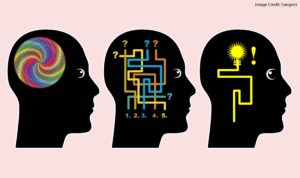Design thinking invites students to approach learning with an engineer’s perspective.
Students begin with a problem, and think their way towards several possible solutions. Each design thinking framework includes its own particulars, but all include variations of these steps:
deliberately explore the problem,
brainstorm several possible solutions,
create those solutions,
repeat these steps as necessary (with healthy doses of metacognition).
Here, for instance, is a 1-pager from Harvard’s Graduate School of Education that summarizes key design-thinking ideas and protocols.
To be confident that this approach has merit, we should ask ourselves two hard questions:
First: do students who learn design thinking apply it in new circumstances? If not, then the method might help students solve a specific problem — but not help them think differently about problems in general.
Second: when students apply design thinking to novel problems, do they learn more than others who don’t? If not, then this new way of thinking doesn’t seem to have made much of a difference.
So: how might we answer these tough questions?
Researchers at Stanford’s School of Education wanted to give it a try…
The Research Plan
A large research team worked with 6th graders in a California public school. They had students practice two distinct design thinking systems.
One group practiced a system that urged them to seek out corrective feedback. That is: they got in the habit of looking for constructive criticism.
A second group practiced a different design-thinking system that emphasized creating several different prototype models before deciding on which one to pursue.
Helpfully, the study design insured that students learned and used these 2 systems in different classes.
Math class (2 weeks)
Social Studies (1 week)
Science (1 week)
A week later, students took a test gave them the chance to apply those skills.
However — and this is the key point — the test didn’t resemble any of the previous design thinking work that they had done. For this reason, the test let researchers answer this question:
“Do students who practice design thinking for a full month spontaneously apply those strategies when facing new, not-obviously-related problems?”
And, given how well they did on this test, it let them answer a second question:
“Do these design thinking strategies help students solve problems more effectively?”
That is: this study design let researchers answer the two hard questions we asked ourselves at the beginning of this post.
Two Answers
This study, I suspect, will be something of a Rorschach test for people who look at its conclusions.
Skeptics — and, by the way, I myself am often in the “skeptic” category — may focus on the most straightforward finding: “there was no stand-alone effect of treatment.”
In other words: the training didn’t have a statistically measurable effect.
Optimists, however, might well have a different take.
To explore their results in greater detail, Chin & Co. analyzed data for the students based on their prior academic accomplishment.
For students in the high-achieving group, and the middle-achieving group, the design thinking training had no statistically measurable effect.
However, for those in the low-achieving group, it certainly did.
An optimist’s summary might go like this.
“Mid- and high-achieving students are ALREADY doing what design thinking teaches. That is, those student ALREADY seek out constructive feedback, and try different models before they decide on one.
The design-thinking training helped low-achieving students behave more like their mid- and high-achieving peers.
That’s great!”
If, in fact, a design thinking curriculum can help some students develop the good learning habits that other students already have, that is in fact great news.
The best way to use design thinking will clearly depend on your own school’s culture and demographics. This study gives us some hope that — used the right way with the right students — it can help students learn.
 About Andrew Watson
About Andrew Watson 








![Why Do “Learning Styles” Theories Persist? [Updated 6-7-19]](https://www.learningandthebrain.com/blog/wp-content/uploads/2019/06/AdobeStock_80919293_Credit-1024x609.jpg)










